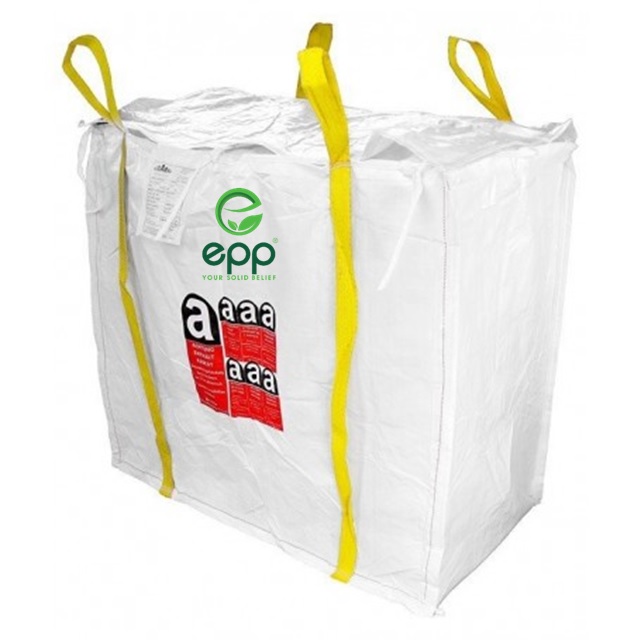How can dried agricultural products be safely and effectively packaged for export using Super Sacks Bags? This is a concern for many producers of dried agricultural products. Therefore, today EPP Vietnam will provide detailed instructions on how to package dried agricultural products for export using bulk bags. You can refer to and apply these instructions.
Concept of Super Sacks Bags
Super Sacks Bags, also known as Flexible Intermediate Bulk Containers (FIBC), are flexible packaging used to contain and transport solid goods such as grains, powders, minerals, etc., in large quantities.

Concept of Super Sacks Bags
Why package dried agricultural products for export with Super Sacks Bags?
There are several reasons why packaging dried agricultural products for export with jumbo bags is a good choice:
Cost savings:
-
Jumbo bags are cheaper compared to other types of packaging such as cartons or woven PP bags.
-
Using jumbo bags helps reduce transportation costs as multiple bags can be stacked on top of each other.
Good product preservation:
-
Super Sacks Bags are made from thick woven materials, which protect the products from external factors such as dust, moisture, and insects.
-
Jumbo bags have good water resistance, helping to preserve the products from damage caused by water.
Ease of use:
-
Jumbo bags have large dimensions, making it easy to load and unload the products.
-
Jumbo bags have lifting handles that facilitate easy handling.
Environmentally friendly:
-
Jumbo bags can be reused multiple times, reducing waste in the environment.
-
Jumbo bags are made from recyclable materials, contributing to environmental protection.
In addition, using jumbo bags also brings other benefits such as:
-
Enhancing the brand image of the business.
-
Making the product easily recognizable in the market.
-
Increasing the competitiveness of the product.
Packaging dried agricultural products for export with Super Sacks Bags
Below are the steps to package dried agricultural products for export with jumbo bags:

Packaging dried agricultural products for export with Super Sacks Bags
Preparation:
-
Choose the appropriate size of jumbo bags based on the dimensions and weight of the products.
-
Clearly and fully print product information on the bags.
-
Prepare necessary tools such as scales, packaging machines, tying strings, etc.
Loading the products into Super Sacks Bags:
-
Weigh the products and place them into the jumbo bags.
-
Gently place the products into the bags to avoid crushing them.
-
Avoid overfilling the bags as it may cause them to tear.
Closing the bags:
There are several methods to close the mouth of the jumbo bags, such as:
-
Using tying strings.
-
Using bag sewing machines.
-
Using adhesive tape.
Stacking the bags:
-
Jumbo bags can be stacked on top of each other to save warehouse space and facilitate transportation.
-
Carefully stack the bags to avoid tearing.
Important considerations when packaging dried agricultural products for export with Super Sacks Bags
To ensure product quality and meet export requirements, you need to consider the following points when packaging dried agricultural products with jumbo bags:

Important considerations when packaging dried agricultural products for export with Super Sacks Bags
Choose the appropriate jumbo bags:
-
Size: Select the appropriate size of jumbo bags based on the weight of the products to be packaged. Avoid choosing bags that are too large or too small to ensure safety and cost-effectiveness.
-
Material: Depending on the type of agricultural products and market requirements, choose suitable materials such as woven PP, kraft, PE-coated, with discharge valves, etc. For example, PE-coated jumbo bags are suitable for products prone to moisture damage
-
Printing: Print complete product information, brand, logo, barcode, export information as required by the target market.
Prepare the products before packaging:
-
Drying: Ensure that the products are completely dried to prevent mold and damage during transportation.
-
Remove impurities: Remove impurities such as branches, leaves, stones, and dust to ensure product quality and save packaging space.
-
Quality inspection: Thoroughly inspect the product quality before packaging to ensure there are no damaged or moldy products.
Transportation considerations:
-
Storage: Store the jumbo bags in a dry, well-ventilated place, away from direct sunlight and high humidity.
-
Loading and unloading: Handle the jumbo bags with care to avoid strong impacts.
-
Choose appropriate transportation methods: Select transportation methods suitable for the type of agricultural products, transportation time, and market requirements.
The above is the method of packaging dried agricultural products for export with Super Sacks Bags. We hope that the information in this article will be helpful to readers. For further information, please contact us using the contact information provided at the end of the article.
🌐 Address: Central Lake 1 Building, Ecopark, Phung Cong Commune, Van Giang District, Hung Yen Province.
🌐 Website:https://epp.vn - https://eppvietnam.trustpass.alibaba.com
📲 +84 986 002 888 - sales@epp.vn



